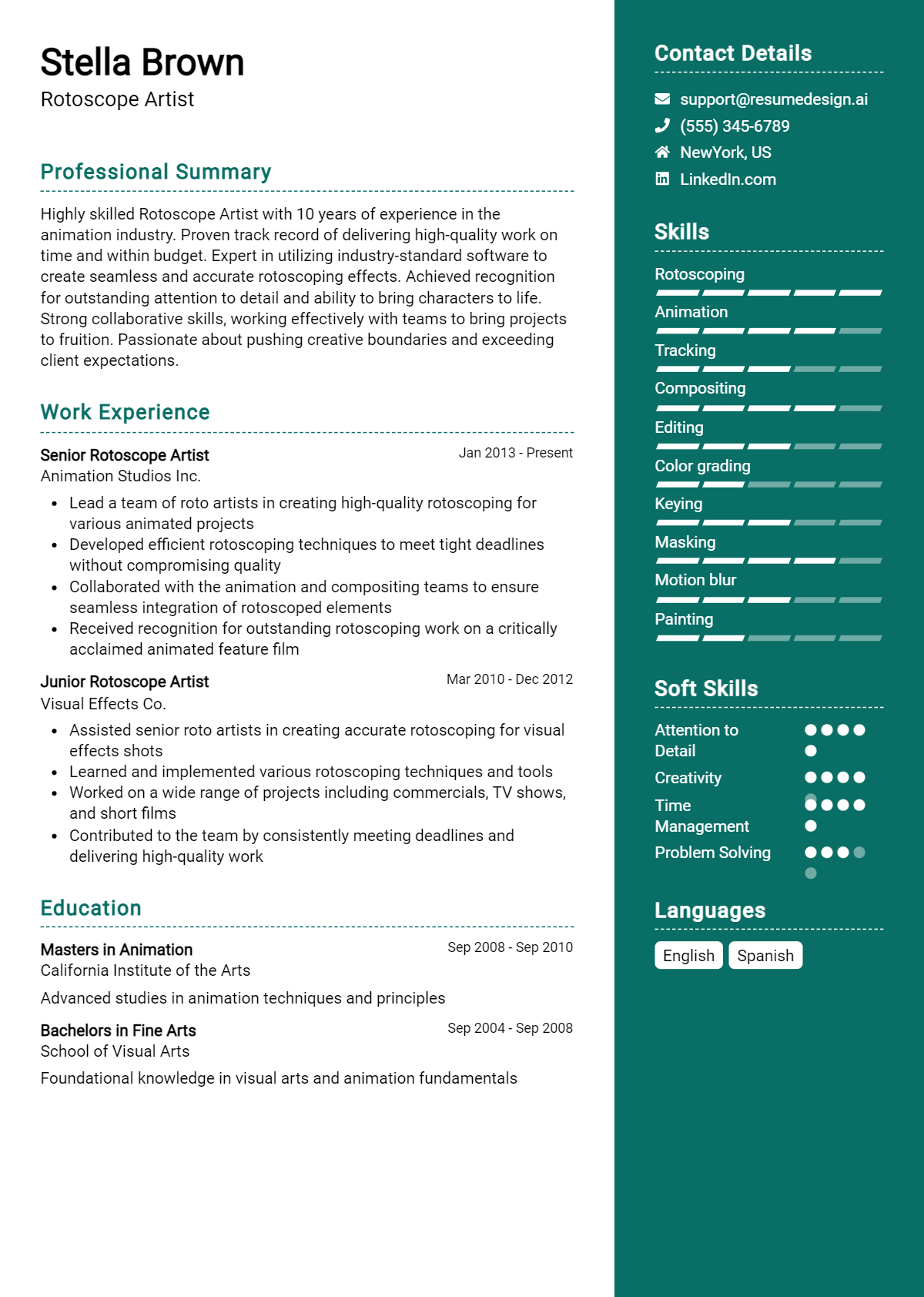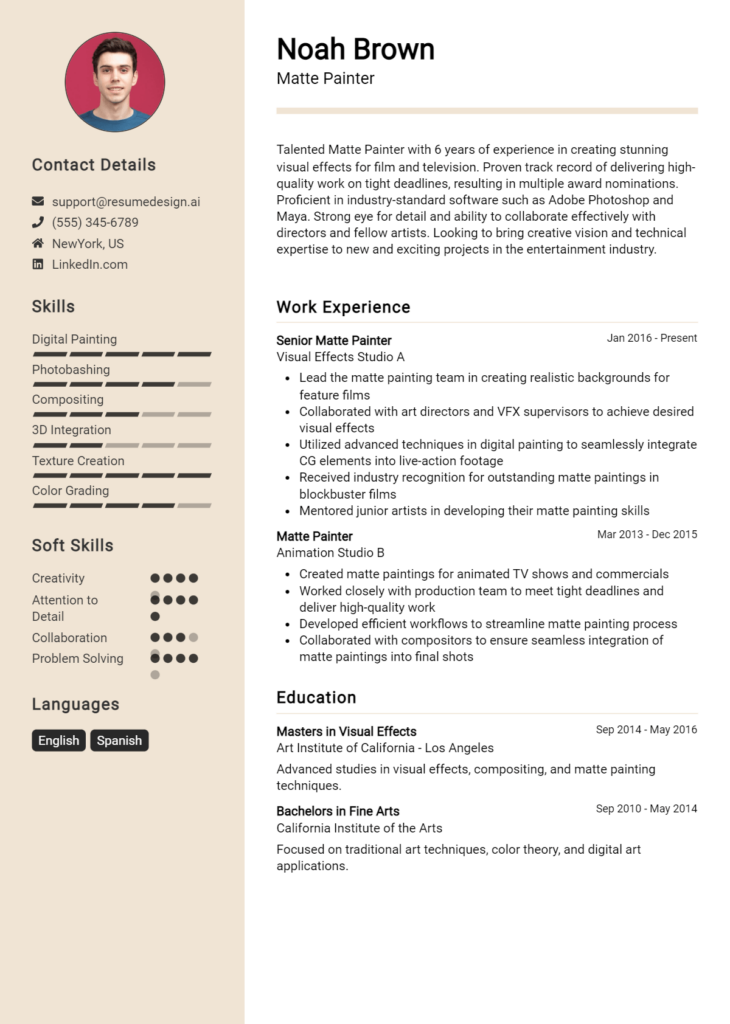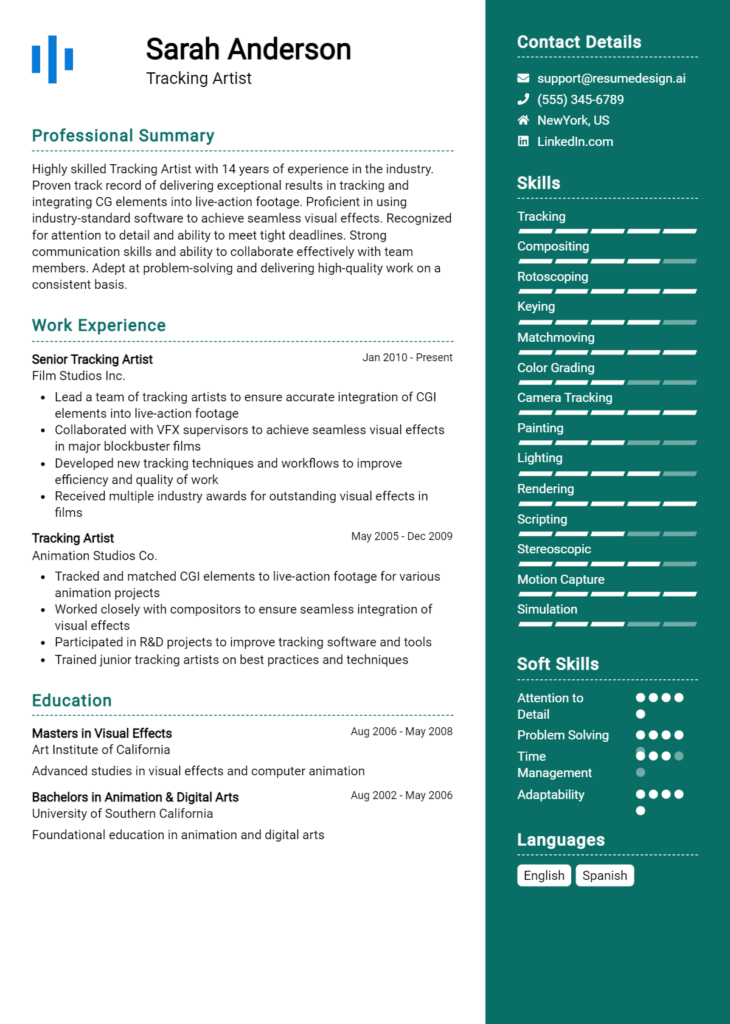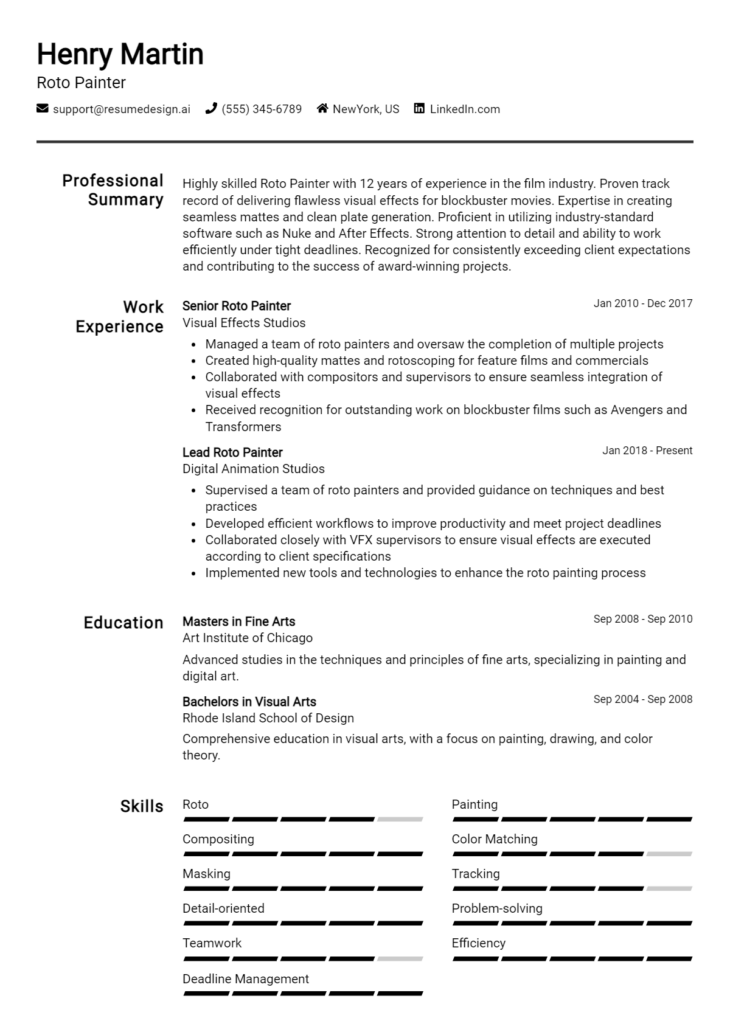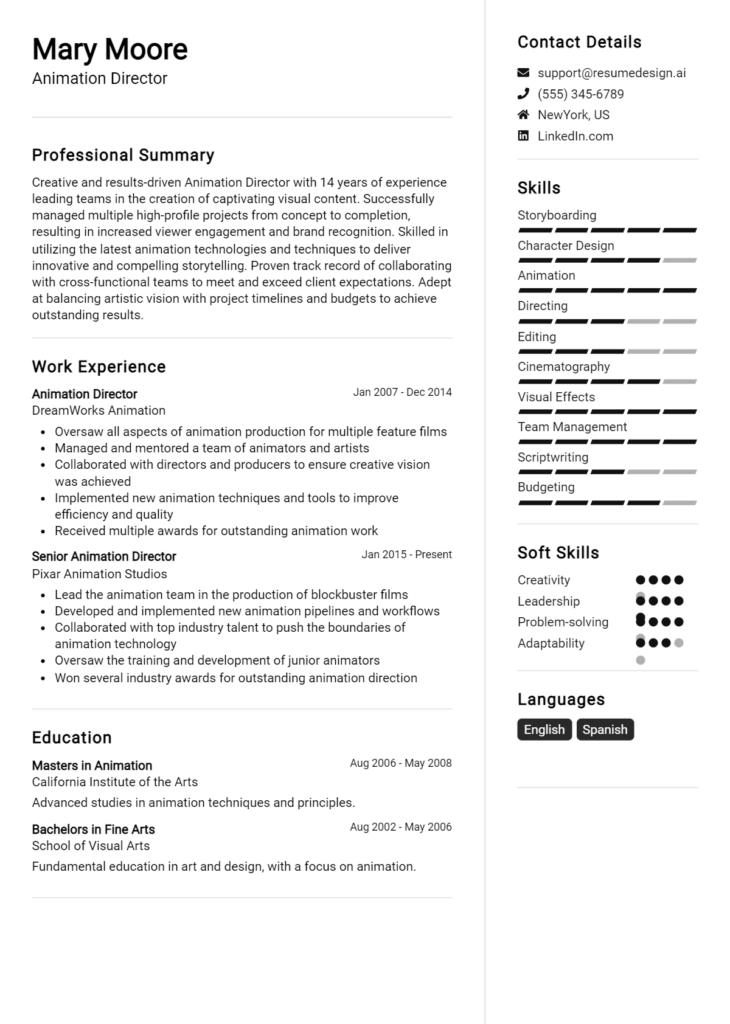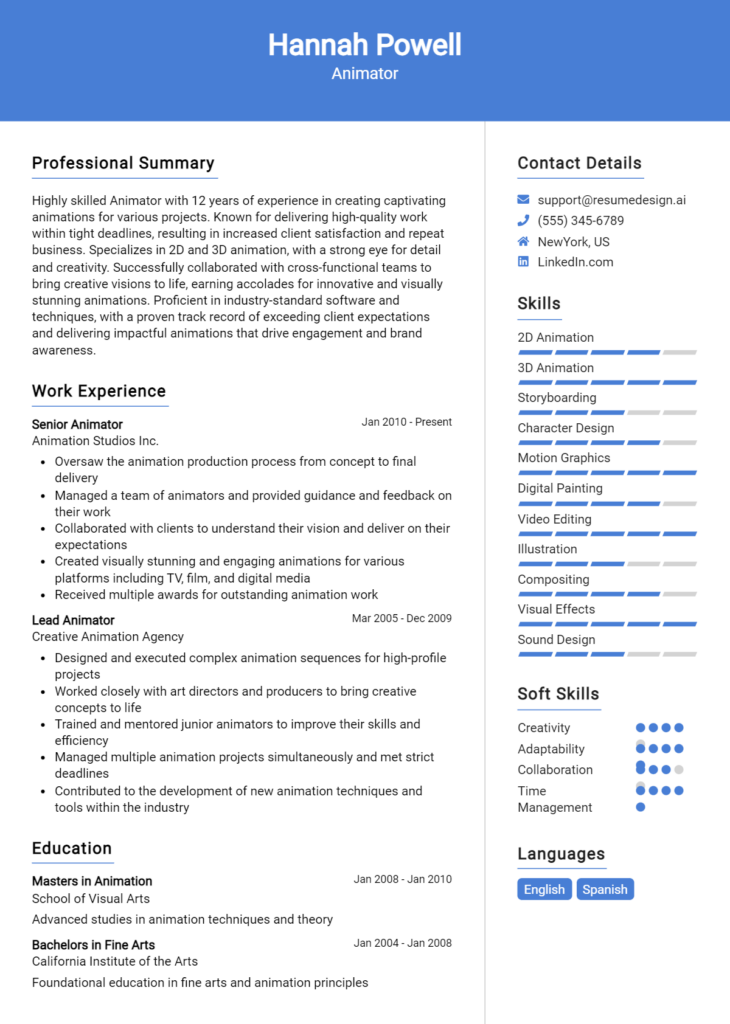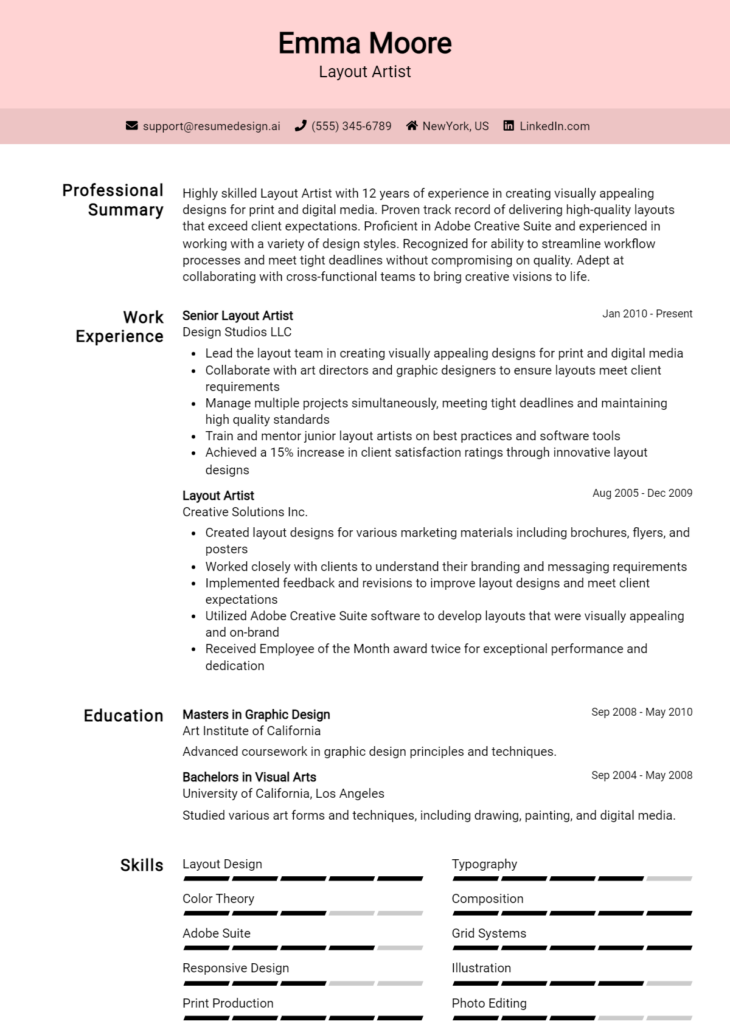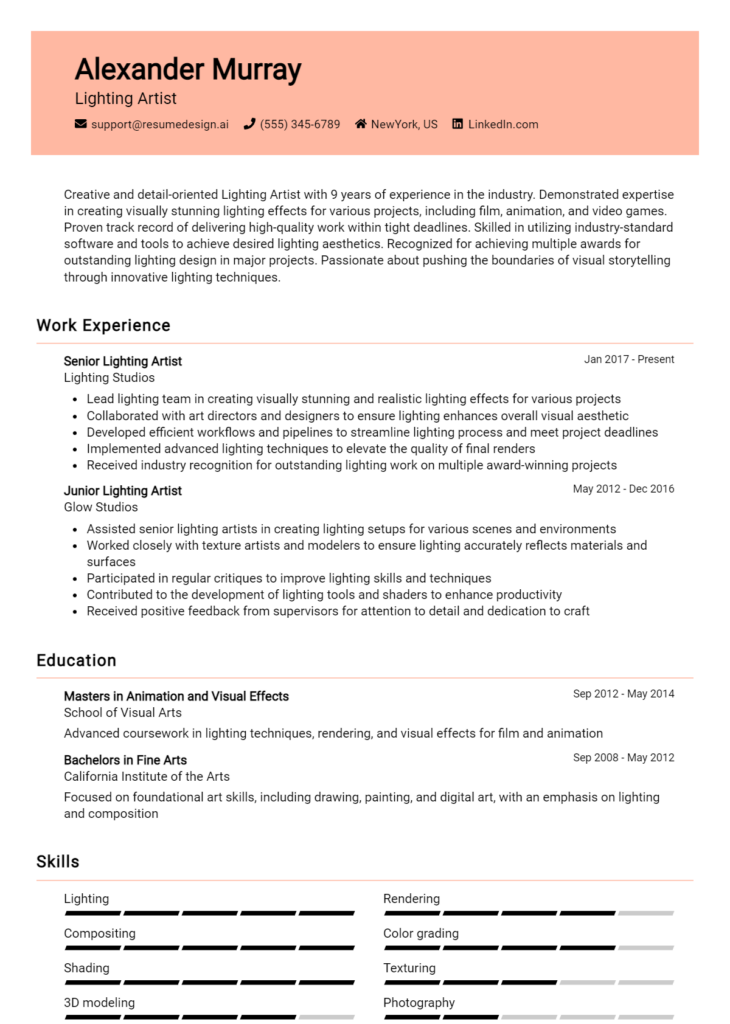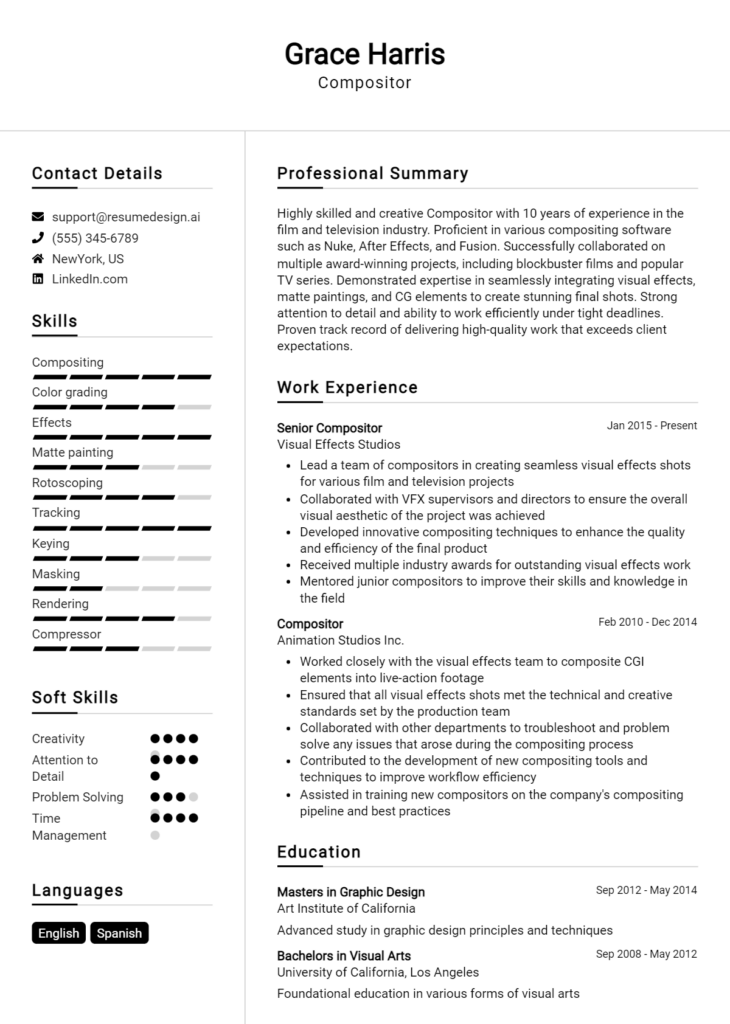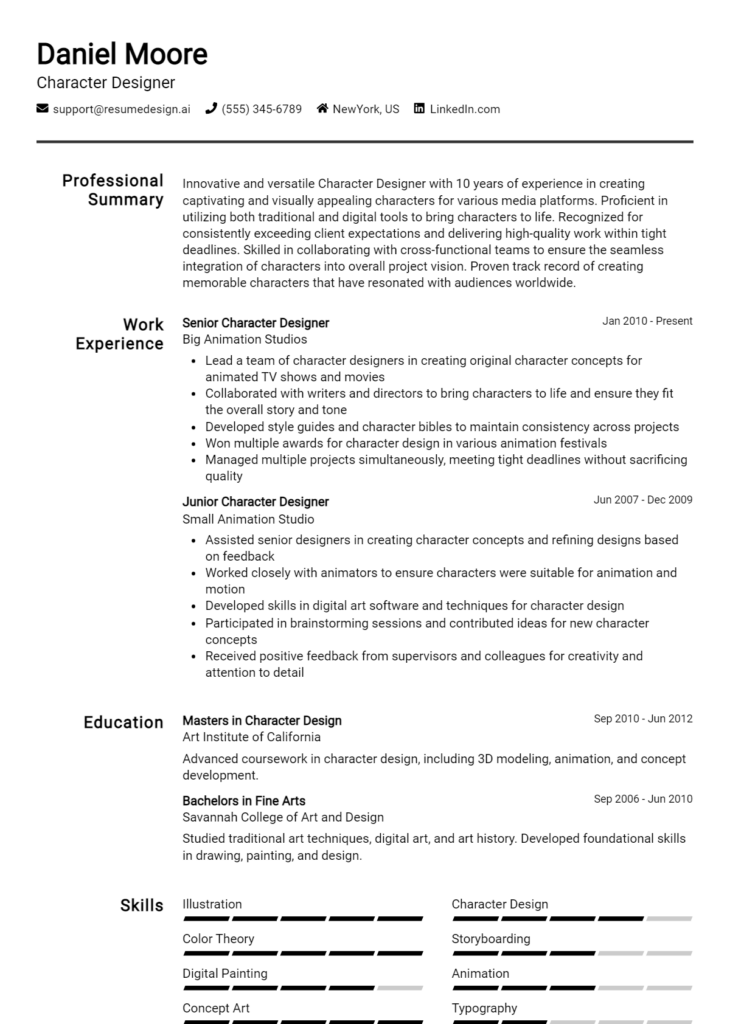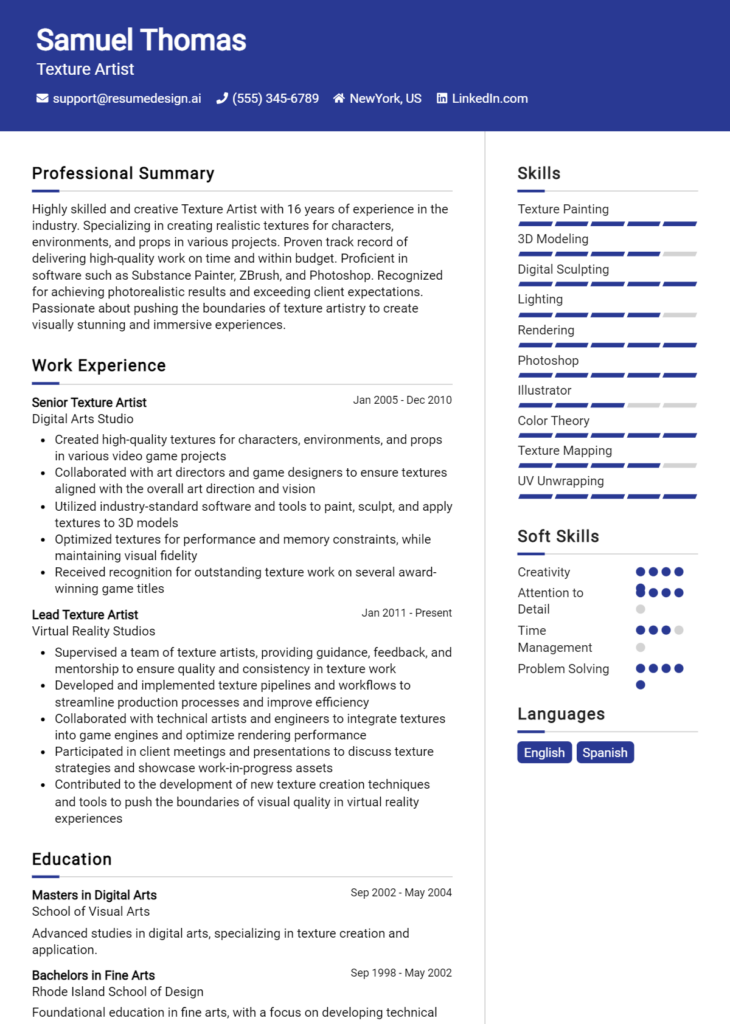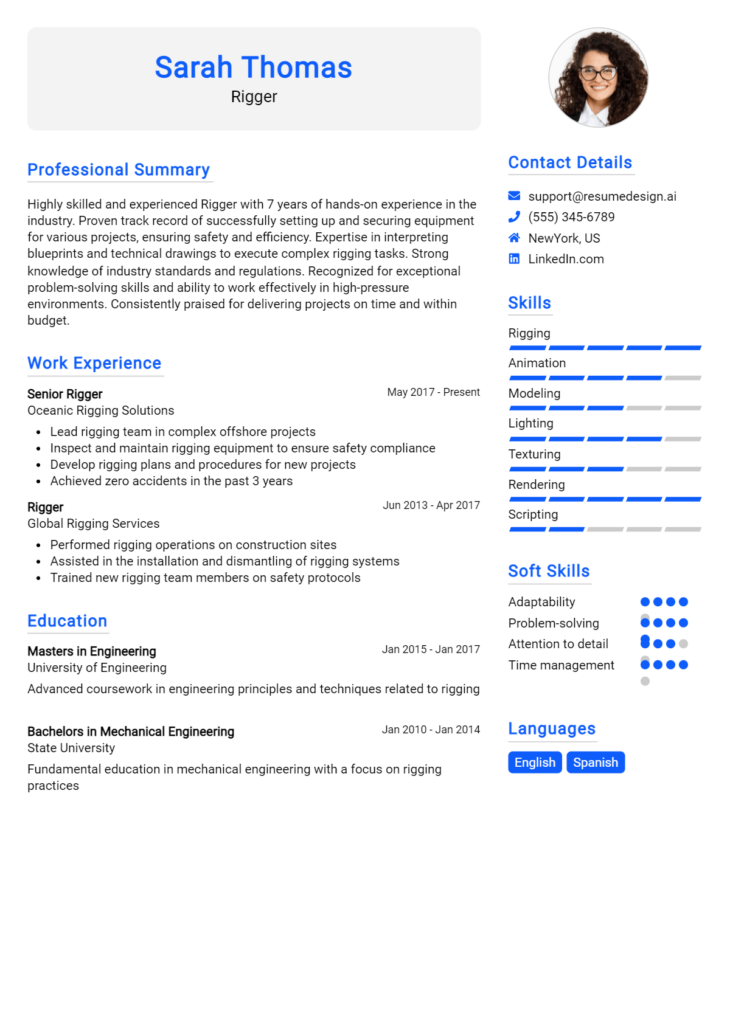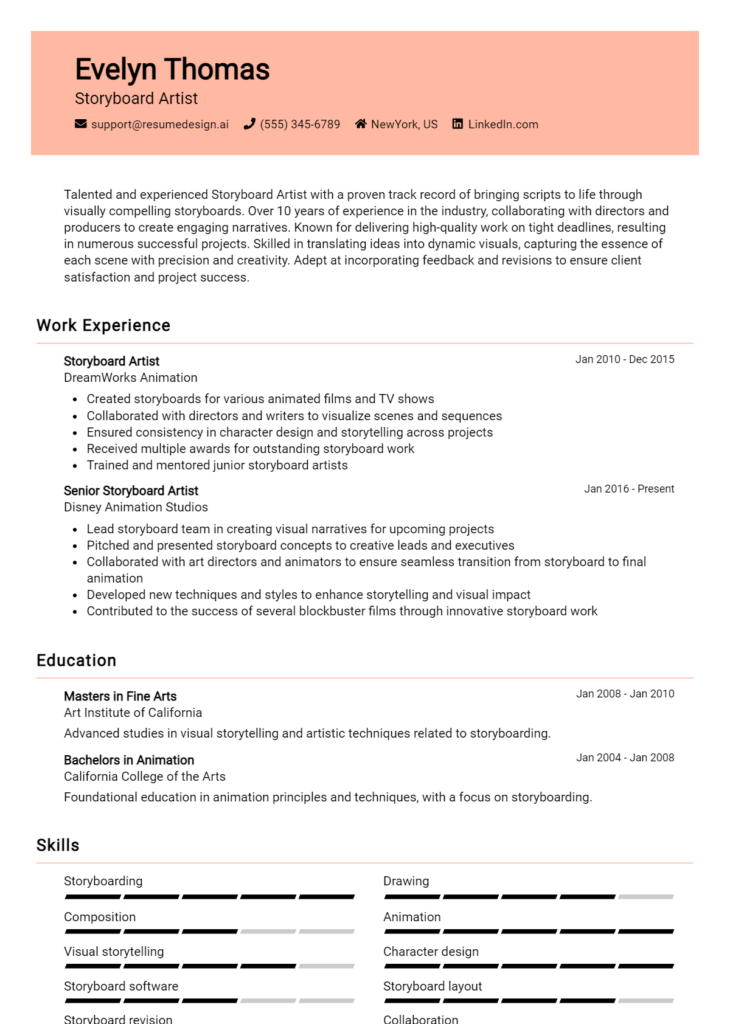Rotoscope Artist Core Responsibilities
A Rotoscope Artist is essential in the animation and visual effects industry, bridging the gap between live-action footage and animated elements. Key responsibilities include meticulously tracing over images to create realistic movement, collaborating closely with animators, and ensuring the seamless integration of visual effects. Technical proficiency in software like Adobe After Effects and strong problem-solving skills are crucial for overcoming challenges that arise during production. A well-structured resume should highlight these qualifications, demonstrating how they contribute to achieving the organization's creative vision and goals.
Common Responsibilities Listed on Rotoscope Artist Resume
- Tracing live-action footage to create animated components
- Collaborating with directors and animators to achieve desired visual effects
- Utilizing software such as Adobe After Effects and Nuke for rotoscoping tasks
- Reviewing and revising work based on feedback from the production team
- Maintaining consistency in style and quality throughout projects
- Managing time effectively to meet project deadlines
- Implementing optical flow and motion tracking techniques
- Creating detailed reports on project progress and challenges
- Ensuring compliance with company standards and artistic guidelines
- Participating in team meetings to discuss project goals and progress
- Conducting quality checks to ensure accuracy and precision in rotoscoping
- Staying updated on industry trends and software advancements
High-Level Resume Tips for Rotoscope Artist Professionals
In the competitive world of animation and visual effects, a well-crafted resume is essential for Rotoscope Artist professionals. As the first impression a candidate makes on a potential employer, the resume must effectively showcase both skills and achievements relevant to the role. It serves as a vital tool to convey your unique artistry and technical proficiency, which can set you apart in a crowded job market. This guide will provide practical and actionable resume tips specifically tailored for Rotoscope Artist professionals, ensuring that your application stands out to hiring managers.
Top Resume Tips for Rotoscope Artist Professionals
- Tailor your resume to each job application by incorporating keywords from the job description.
- Highlight relevant experience in rotoscoping, animation, and visual effects, including specific projects you've worked on.
- Quantify your achievements by including metrics, such as the number of frames completed or projects delivered ahead of schedule.
- Showcase your proficiency in industry-standard software, such as Adobe After Effects and Nuke, to demonstrate your technical skills.
- Include a strong portfolio link that showcases your best rotoscoping work, allowing employers to see your skills in action.
- Utilize clear and concise language, focusing on impactful action verbs to describe your contributions.
- Incorporate any relevant certifications or training, such as courses in animation or visual effects.
- Highlight teamwork and collaboration experience, as rotoscoping often requires working closely with directors and other artists.
- Keep the design clean and professional, ensuring that your resume is easy to read and visually appealing.
- Proofread carefully to eliminate any errors, as attention to detail is crucial in the field of visual effects.
By implementing these tips, Rotoscope Artist professionals can significantly increase their chances of landing a job in the field. A focused and polished resume not only highlights your qualifications but also demonstrates your commitment to the craft, making you a more attractive candidate to potential employers.
Why Resume Headlines & Titles are Important for Rotoscope Artist
In the competitive field of visual effects, a Rotoscope Artist plays a crucial role in the post-production process, meticulously tracing over motion picture footage to create realistic animations or visual effects. When applying for a position, the importance of resume headlines and titles cannot be overstated. A strong headline or title serves as the first impression and can immediately captivate hiring managers, summarizing a candidate's key qualifications in one impactful phrase. It should be concise, relevant, and directly aligned with the job being applied for, ensuring that it highlights the candidate’s unique skills and experience right from the start.
Best Practices for Crafting Resume Headlines for Rotoscope Artist
- Keep it concise: Aim for a headline that is brief yet informative, ideally within 10-15 words.
- Be role-specific: Use terminology and keywords specific to the Rotoscope Artist position.
- Highlight key skills: Incorporate strong skills or tools that are relevant to rotoscoping.
- Showcase experience level: Indicate whether you are an entry-level, mid-level, or senior Rotoscope Artist.
- Use action words: Start with powerful verbs to convey your capabilities dynamically.
- Tailor to the job: Customize your headline for each application to reflect the specific job requirements.
- Avoid jargon: Ensure clarity by avoiding overly technical terms that might confuse non-specialist reviewers.
- Invoke creativity: Rotoscoping is an art; your headline should reflect creativity and innovation.
Example Resume Headlines for Rotoscope Artist
Strong Resume Headlines
Experienced Rotoscope Artist Specializing in Seamless Visual Effects
Creative Rotoscope Artist with 5 Years of Industry Experience
Detail-Oriented Rotoscope Artist Proficient in Adobe After Effects and Mocha
Award-Winning Rotoscope Artist with Proven Track Record in Feature Films
Weak Resume Headlines
Rotoscope Artist Looking for Work
Experienced Worker in Animation
The strong headlines are effective because they convey specific skills, experience, and accomplishments that are relevant to the Rotoscope Artist role, making them stand out to hiring managers. In contrast, the weak headlines fail to impress as they are vague and lack any clear indication of the candidate’s qualifications or what makes them unique, ultimately blending into a sea of generic applications.
Writing an Exceptional Rotoscope Artist Resume Summary
A resume summary is a critical element for a Rotoscope Artist as it serves as a first impression to hiring managers, quickly capturing their attention by showcasing essential skills, experience, and accomplishments relevant to the role. A strong summary can set a candidate apart in a competitive job market by being concise yet impactful, emphasizing specific competencies in rotoscoping, visual effects, and animation. Tailoring the summary to the specific job description not only demonstrates a keen understanding of the position but also conveys enthusiasm and suitability for the role.
Best Practices for Writing a Rotoscope Artist Resume Summary
- Quantify Achievements: Use numbers to highlight your accomplishments, such as projects completed on time or improvements in workflow efficiency.
- Focus on Relevant Skills: Include specific software and techniques you excel in, such as After Effects, Nuke, or frame-by-frame animation.
- Tailor the Summary: Customize your summary for each job application to reflect the requirements and language of the job description.
- Highlight Industry Experience: Mention the types of projects worked on, such as commercials, films, or video games, to demonstrate your breadth of experience.
- Use Action-Oriented Language: Start sentences with strong action verbs to convey confidence and proactivity in your work.
- Keep it Concise: Aim for 3-5 sentences that effectively summarize your qualifications without being overly verbose.
- Showcase Collaborative Work: If applicable, mention your experience working in teams or with directors and producers to highlight your collaborative skills.
- Include Awards or Recognition: If you have received any industry awards or acknowledgments, be sure to mention them to add credibility.
Example Rotoscope Artist Resume Summaries
Strong Resume Summaries
Detail-oriented Rotoscope Artist with over 5 years of experience in the visual effects industry, delivering high-quality frame-by-frame animations for 15+ feature films and commercials. Proficient in Adobe After Effects and Nuke, with a proven track record of improving workflow efficiency by 30% through innovative techniques.
Creative Rotoscope Artist skilled in transforming raw footage into captivating visual narratives. Successfully collaborated on award-winning projects, enhancing the visual quality of animations and earning a nomination for Best Visual Effects at the XYZ Film Festival.
Dedicated Rotoscope Artist with expertise in live-action compositing and character animation. Known for delivering exceptional results under tight deadlines, having completed over 50 projects within budget and timeline constraints, contributing to a 20% increase in client satisfaction ratings.
Weak Resume Summaries
Rotoscope Artist with some experience in animation. Good at working on projects and collaborating with teams.
I have worked as a Rotoscope Artist and have some skills in software. I am looking for opportunities to grow in the industry.
The examples provided highlight the differences between strong and weak resume summaries. Strong summaries are specific, quantifiable, and demonstrate direct relevance to the Rotoscope Artist role, showcasing concrete achievements and skills. In contrast, weak summaries lack detail, are overly vague, and fail to convey a clear sense of the candidate's capabilities or impact, making them less compelling to hiring managers.
Work Experience Section for Rotoscope Artist Resume
The work experience section of a Rotoscope Artist resume is crucial as it serves as a platform to showcase the candidate's technical skills and their ability to deliver high-quality visual effects. This section not only highlights prior experiences but also demonstrates the candidate's proficiency in using rotoscoping tools and software, their capability to manage and collaborate with teams, and their success in producing outstanding results. By quantifying achievements and aligning experiences with industry standards, a strong work experience section can effectively set a candidate apart in a competitive field.
Best Practices for Rotoscope Artist Work Experience
- Highlight specific software and tools used in rotoscoping, such as Adobe After Effects, Nuke, or Mocha.
- Quantify achievements where possible, such as the number of frames processed or deadlines met.
- Showcase collaboration with directors, animators, and other departments to illustrate teamwork skills.
- Use action verbs to describe contributions, emphasizing proactive problem-solving abilities.
- Include project names and details to provide context and demonstrate industry relevance.
- Tailor experiences to align with the job description, emphasizing relevant skills for each application.
- Highlight any leadership roles or mentorship experiences within project teams.
- Demonstrate adaptability by mentioning experience with different animation styles or techniques.
Example Work Experiences for Rotoscope Artist
Strong Experiences
- Led a team of 5 rotoscope artists on a feature film project, resulting in a 20% decrease in post-production time and recognition from the director for outstanding visual quality.
- Successfully completed over 1,000 frames of complex character animation for a high-profile animated series, contributing to a 95% client satisfaction score.
- Implemented new rotoscoping techniques that improved workflow efficiency by 30%, allowing the team to take on additional projects without compromising quality.
- Collaborated closely with the visual effects department to create seamless transitions in a blockbuster film, enhancing the overall visual narrative and earning a nomination for Best Visual Effects.
Weak Experiences
- Worked on various projects as a rotoscope artist, completing tasks as assigned.
- Assisted with rotoscoping and other animation jobs as needed.
- Participated in team meetings and contributed to discussions about animation techniques.
- Helped with editing and post-production processes occasionally.
The examples provided highlight the difference between strong and weak experiences in a Rotoscope Artist's resume. Strong experiences are characterized by specific details, quantifiable results, and a clear demonstration of leadership and collaboration, which effectively communicate the candidate's value and impact on projects. In contrast, weak experiences lack specificity and measurable outcomes, failing to convey a sense of accomplishment or technical expertise, ultimately making them less compelling to potential employers.
Education and Certifications Section for Rotoscope Artist Resume
The education and certifications section of a Rotoscope Artist resume plays a crucial role in establishing the candidate's qualifications and expertise in the field. This section not only showcases the academic background of the individual but also highlights any industry-relevant certifications and ongoing learning initiatives. By including relevant coursework, specialized training, and recognized credentials, candidates can significantly enhance their credibility and demonstrate their commitment to mastering the skills essential for success in rotoscoping and visual effects. This emphasis on education and certifications can set them apart in a competitive job market.
Best Practices for Rotoscope Artist Education and Certifications
- Highlight industry-recognized certifications relevant to rotoscoping and visual effects.
- Include relevant coursework that demonstrates knowledge of animation, visual effects, or digital art.
- Keep the education section concise but informative, focusing on degrees and certifications pertinent to the role.
- List certifications from reputable organizations that are current and well-regarded in the industry.
- Showcase any specialized training or workshops attended that enhance your rotoscoping skills.
- Consider including online courses or MOOCs that relate to software commonly used in rotoscoping.
- Use clear formatting to make this section easily scannable for hiring managers.
- Provide dates of completion for certifications to indicate the currency of your knowledge.
Example Education and Certifications for Rotoscope Artist
Strong Examples
- Bachelor of Fine Arts in Animation, University of Southern California, 2021
- Certified Visual Effects Artist, Academy of Art University, 2022
- Advanced Rotoscoping Techniques Workshop, SIGGRAPH Conference, 2023
- Relevant Coursework: 3D Animation, Motion Graphics, Digital Compositing
Weak Examples
- Associate Degree in General Studies, Community College, 2019
- Certification in Basic Computer Skills, Online Course, 2020
- Diploma in Graphic Design (non-specific), Art School, 2018
- Workshop on Traditional Painting Techniques, Local Art Studio, 2021
The strong examples are considered effective because they directly relate to the skills and knowledge necessary for a Rotoscope Artist, showcasing relevant degrees, certifications, and coursework that align with current industry standards. In contrast, the weak examples lack specificity and relevance to the rotoscoping role, highlighting outdated or unrelated qualifications that do not enhance the candidate's suitability for the position. This distinction underscores the importance of including only pertinent educational achievements and credentials in the resume.
Top Skills & Keywords for Rotoscope Artist Resume
As a Rotoscope Artist, the ability to showcase both hard and soft skills on your resume is crucial for standing out in a competitive field. Hard skills demonstrate your technical expertise and proficiency with various tools and software used in the animation and visual effects industry, while soft skills highlight your ability to work collaboratively and effectively within a team. A well-crafted resume that emphasizes these skills not only showcases your qualifications but also conveys your readiness to tackle the challenges of the role. For those looking to refine their resume, it's essential to incorporate relevant skills and effectively present your work experience.
Top Hard & Soft Skills for Rotoscope Artist
Soft Skills
- Attention to Detail
- Time Management
- Communication Skills
- Team Collaboration
- Problem-Solving
- Adaptability
- Creativity
- Critical Thinking
- Organizational Skills
- Patience
Hard Skills
- Proficiency in Adobe After Effects
- Knowledge of Rotoscoping Techniques
- Experience with Animation Software (e.g., Toon Boom, Nuke)
- Understanding of Color Theory
- Familiarity with Compositing Techniques
- Strong Drawing Skills
- Knowledge of Video Editing Software
- Familiarity with 3D Animation
- Understanding of Motion Graphics
- Ability to Work with High-Resolution Footage
Stand Out with a Winning Rotoscope Artist Cover Letter
Dear [Hiring Manager's Name],
I am writing to express my interest in the Rotoscope Artist position at [Company Name] as advertised on [where you found the job listing]. With a strong background in animation and visual effects, combined with my passion for bringing creative visions to life, I am excited about the opportunity to contribute to your team. My experience in rotoscoping for various projects has equipped me with the technical skills and artistic sensibility necessary to excel in this role.
In my previous position at [Previous Company Name], I collaborated closely with animators and visual effects artists to create seamless visual experiences. I have honed my skills in utilizing industry-standard software such as Adobe After Effects and Nuke, allowing me to efficiently create precise masks and animations. My attention to detail and commitment to meeting project deadlines ensured that I consistently delivered high-quality work that met the artistic direction of each project. I am particularly proud of my contribution to [specific project or achievement], where my rotoscoping work significantly enhanced the final outcome.
I am drawn to [Company Name] because of your innovative approach to storytelling and commitment to pushing the boundaries of visual effects. I am eager to bring my own creative insights and technical expertise to your team. I thrive in collaborative environments and believe that my ability to communicate effectively with cross-functional teams will allow me to make a positive impact on your projects from day one. I am enthusiastic about the possibility of working alongside talented artists who share my dedication to excellence in animation.
Thank you for considering my application. I look forward to the opportunity to discuss how my skills and experiences align with the needs of your team. I am excited about the chance to contribute to the creative projects at [Company Name] and help bring extraordinary visuals to life.
Sincerely,
[Your Name]
[Your Contact Information]
[Your LinkedIn Profile or Portfolio Link]
Common Mistakes to Avoid in a Rotoscope Artist Resume
A well-crafted resume is essential for a Rotoscope Artist to stand out in a competitive field. However, many candidates make common mistakes that can detract from their qualifications and reduce their chances of landing an interview. Understanding these pitfalls can help you present your skills and experience more effectively. Here are some common mistakes to avoid when creating your Rotoscope Artist resume:
Neglecting to Tailor the Resume: Failing to customize your resume for each job application can make it seem generic. Tailoring your resume to highlight relevant skills and experiences for specific roles demonstrates your genuine interest in the position.
Lack of Specificity: Being vague about your skills and experiences can leave hiring managers unsure about your capabilities. Instead of using general terms, specify the software you are proficient in (e.g., Nuke, After Effects) and describe your role in specific projects.
Ignoring the Importance of a Portfolio: A resume without a portfolio link can undermine your application. As a Rotoscope Artist, showcasing your work is crucial; provide a link to your online portfolio or showreel to highlight your best projects.
Overloading with Technical Jargon: While it’s important to showcase your technical skills, too much jargon can alienate non-technical readers. Strike a balance by explaining complex terms in simple language when possible.
Omitting Relevant Experience: Failing to include freelance work, internships, or personal projects can lead to an incomplete picture of your experience. Even if it’s not professional work, any relevant experience should be highlighted to show your dedication to the craft.
Using an Unprofessional Format: A cluttered or overly complex layout can distract from your content. Stick to a clean, professional format with clear headings and bullet points for easy readability.
Ignoring Soft Skills: While technical abilities are crucial for a Rotoscope Artist, soft skills like communication and teamwork are equally important in collaborative environments. Highlight these attributes to demonstrate your well-roundedness as a candidate.
Including Irrelevant Information: Adding unrelated work experience or hobbies can dilute the focus of your resume. Keep your content relevant to the role of a Rotoscope Artist to maintain clarity and impact.
Conclusion
As a Rotoscope Artist, your role is crucial in the animation and visual effects industry, requiring a keen eye for detail and a strong understanding of motion graphics. Throughout our discussion, we highlighted the essential skills needed for this position, including proficiency in software like Adobe After Effects and the ability to work collaboratively within a team. We also covered the importance of building a compelling portfolio that showcases your best work, alongside tips on how to present your experience effectively.
To ensure you stand out in a competitive job market, it's essential to have a polished resume that highlights your unique skills and experiences. We encourage you to take the time to review and enhance your Rotoscope Artist resume. Make use of the available resources to streamline this process. Check out our resume templates for a professional layout, utilize our resume builder for easy customization, and explore resume examples to get inspiration. Additionally, don’t forget to craft an impressive cover letter with our cover letter templates.
By investing time in your resume and application materials, you can significantly improve your chances of landing your dream role as a Rotoscope Artist. Take action today and make sure your application reflects your skills and creativity!

